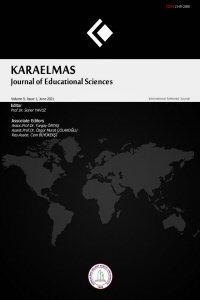Evrensel Tasarıma Dayalı Öğrenme ve Evrensel Olarak Tasarlanmış Eğitim Programlar
Evrensel tasarım, mimari alanında ortaya çıkmış bir yaklaşımdır. Evrensel tasarıma dayalı öğrenme ise bu yaklaşımın ilkelerinin eğitime uygulanmasına dayalıdır. Evrensel tasarıma dayalı öğrenme, öğrenmeyi sağlamada beynin üç geniş ağını göz önünde bulundurur. Bunlar tanıma ağları, stratejik ağlar ve duyuşsal ağlardır. Evrensel tasarıma dayalı öğrenme öğrenci merkezli bir yaklaşım olup öğretim programlarının tüm öğrencilere hitap edecek şekilde tasarlanması gerektiğini savunur. Öğretim programları amaçlar, öğretim yöntemleri, öğretim materyalleri ve ölçme-değerlendirme öğelerinden oluşur. Öğretim programları tasarlanırken öğrencilerin ilgi, ihtiyaç ve yetenekleri göz önünde bulundurulur. Öğrencilerin öğrenme engelleri tespit edilir, bu engelleri ortadan kaldıracak şekilde alternatif uygulamalar planlanır. Böylece tüm öğrencilere eşit şartlarda öğrenme imkanı sunulmuş olur
Anahtar Kelimeler:
Evrensel Tasarıma Dayalı Öğrenme, Evrensel Tasarıma Dayalı Öğretim, Evrensel Olarak Tasarlanmış
Universal Design for Learning and Universally Designed Curricula
Universal design is an approach that has emerged in architecture. “Universal design for learning” is based on the application of the principles of this approach to education. Universal design for learning considers three broad networks of brain. These networks are recognition networks, strategical networks and affective networks. This approach is learner centered.Universally designed curricula are designed for all learners. Components of universally designed curriculum are goals, methods, materials, and assessment. Curricula are designed according to learners’ interests, needs, and ability. To this approach, there might be barriers between learners and learning. So, alternative activities are planned in universally designed curriculum. This case provides equal access to learning for all learners
Keywords:
Universal Design for Learning Universal Design of Instruction, Universally Designed Curriculum, Universal Design in Education,
___
- Burgstahler, S. (2007a). Equal access: Universal design of instruction. 30.03. 2017 tarihinde http://www.washington.edu/doit/sites/default/files/atoms/files/Equal-Access-Universal-Design-ofInstruction.pdf adresinden alınmıştır.
- Burgstahler, S. (2007b). Universal Design in Education: Principles and Applicaitons. 03 30, 2017 tarihinde http://files.eric.ed.gov/fulltext/ED506545.pdf adresinden alındı
- CAST (2011). Universal design for learning guideline: Version 2.0. Wakefield, Author, MA.
- CAST (2017). http://www.cast.org/adresinden 14.06.2017 tarihinde alınmıştır.
- Connell, B. R., Jones, M., Mace, R., Mueller, J., Mullick, A., Ostroff, E. &Vanderheiden, G. (1997). The Principles of universal design, Version 2. 06. 13. 2017 tarihinde https://www.ncsu.edu/ncsu/design/cud/about_ud/udprinciplestext.htm adresinden alınmıştır.
- Eaglaton, M. (2008). Universal design for learning. EBSCO Publishing. 06. 10. 2017 tarihinde https://www.ebscohost.com/uploads/imported/thisTopic-dbTopic-1073.pdf adresinden alınmıştır.
- Hitchcock, C. & Stahl, S. (2003). Assistive technology, universal design, universal design for learning: improved learning opportunities. Journal of Special Education Technology, 18(4), 45-52.
- Hitchcock, C., Meyer, A., Rose, D. & Jackson, R. (2002). Providing new access to the generel curriculum universal design for learning. Teaching Exceptional Children, 8-17.
- Meo, G. (2008). Curriculum planning for all learners: Applying universal design for learning (udl) to a high school reading comprehension program. Preventing School Failure, 52(2), 21-30.
- Meyer, A., Rose, D. & Gordon, D. (2014). Universal design for learning: theory and practice. Wakefield, MA: CAST.
- Nelson, L. L. (2014). Design and deliver: Planning and teaching using universal design for learning. Baltimore: Paul H. Brookes Publishing.
- Novak, K. (2014). UDL now: A teacher's monday- morning guide to ımplementing common core standarts using universal design for learning. Wikefield: CAST Professional Publishing.
- Ralabate, P. K. (2011). Universal design for learning: Meeting the needs of all students. ASHA Leader, 16, 14-17.
- Ralabate, P. K. (2016). Your UDL lesson planner step by step guide for teaching all learners. Baltimore: Brookes.
- Rose, D. (2000). Universal design for learning. Journal of Special Education Technology, 15 (1), 67-70.
- Rose, D. (2001). Universal design for learning: Driving guiding principles for networks that learn. Journal of Special Education Technology, 16(2), 66-67.
- Rose, D. H. & Strangman, N. (2007). Universal design for learning: meeting the challenge of ındividual learning differences through a neurocognitive perspective. Universal Access in the Information Society, 5, 381-391.
- Rose, D. & Meyer, A. (2002). Teaching every student in the digital age: Universal design for learning. Virginia:ASCD UDLCENTER (2017a). UDL and expert learners. http://www.udlcenter.org/aboutudl/expertlearners adresinden 30.11.207 tarihinde alınmıştır.
- UDLCENTER (2017b). UDL guidelines: Version 2.0. http://www.udlcenter.org/aboutudl/udlguidelines adresinden 17.11.2017 tarihinde alınmıştır.
- UDLCENTER (2017c). What is meant by the term curriculm. http://www.udlcenter.org/aboutudl/udlcurriculum adresinden 09.11.2017 tarihinde alınmıştır.
- ISSN: 2148-2888
- Yayın Aralığı: Yılda 2 Sayı
- Başlangıç: 2013
- Yayıncı: Zonguldak Bülent Ecevit Üniversitesi
Sayıdaki Diğer Makaleler
Grup Değişmezliği Özelliğinin Farklı Eşitleme Yöntemlerinde İncelenmesi
Hande TANBERKAN SUNA, Şeref TAN
İnternet Teknolojilerinin Yükseköğretime Etkileri
Çocuk Haftası Dergisinin Çocuk Edebiyatı Açısından İncelenmesi
Matematik Öğretiminde Birlikte Öğrenme Tekniğinin Kullanılması ve Değerlendirilmesi
Evrensel Tasarıma Dayalı Öğrenme ve Evrensel Olarak Tasarlanmış Eğitim Programlar
Ortaokul Öğrencilerinin Sayı Duyularının Okul Türleri Açısından İncelenmesi
Yabancı Dil Öğrenenlerin Motivasyon Kaynağı: İdeal Dil Benliği
Öğretmen Adaylarının Sosyal Medya Kavramına İlişkin Algıları
